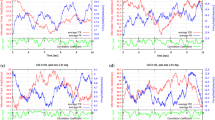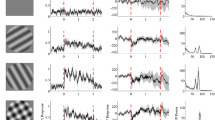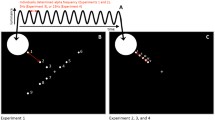Summary
We tested the hypothesis that geniculate X cells are the neural substrate of psychophysically identified pattern channels and that geniculate Y cells are the neural substrate of psychophysically identified flicker channels. The hypothesis was tested by measuring the relative sensitivity of isolated X and Y cells in the dorsal lateral geniculate nucleus of the cat to counterphase and on-off grating presentations. The fundamental and second harmonic responses of X and Y cells to sinusoidal counterphase and on-off temporal modulation were measured at a number of spatial frequencies using two contrasts, 0.1 and 0.4. The fundamental responses of both X and Y cells to sinusoidal counterphase were greater relative to on-off responses. The second harmonic responses of Y cells to counterphase were larger at high spatial frequencies. Contrast sensitivity also was measured. At all spatial frequencies, both X and Y cells were slightly more sensitive to counterphase than to on-off presentations. Since flicker sensitivity in humans is twice as high for counterphase as for on-off presentations across all spatial frequencies, whereas pattern sensitivity is equal for the two presentations, we conclude that X and Y cells do not subserve uniquely pattern and flicker sensitivity, respectively. This conclusion is based on the result that differences between X and Y cells to counterphase and on-off presentations were inconsistent with the differences observed for pattern and flicker sensitivity. We suggest then that a spatial/temporal dichotomy does not seem to accurately characterize the functional roles of X and Y cells.
Similar content being viewed by others
References
Blake R, Camisa JM (1977) Temporal aspects of spatial vision in the cat. Exp Brain Res 28: 325–333
Breitmeyer BG, Ganz L (1976) Implications of sustained and transient channels for theories of visual pattern masking, saccadic suppression, and information processing. Psychol Rev 83: 1–36
Cleland BG, Dubin MW, Levick WR (1971) Sustained and transient cells in the cat's retina and lateral geniculate nucleus. J Physiol (Lond) 217: 473–496
Derrington AM, Fuchs AF (1979) Spatial and temporal properties of X and Y cells in the cat lateral geniculate nucleus. J Physiol (Lond) 293: 347–364
Enroth-Cugell C, Robson J (1966) The contrast sensitivity of retinal ganglion cells of the cat. J Physiol (Lond) 187: 517–552
Essock EA, Lehmkuhle S (1982) The oblique effects of pattern and flicker sensitivity: Implications for mixed physiological input. Perception 11: 441–455
Fukada Y, Saito H (1971) The relationship between response characteristics to flicker stimulation and receptive field organization in the cat's optic nerve fibres. Vision Res 11: 227–240
Green M (1981) Psychophysical relationships among mechanisms sensitive to pattern, motion, and flicker. Vision Res 21: 971–984
Hochstein S, Shapley RM (1976a) Quantitative analysis of retinal ganglion cell classifications. J Physiol (Lond) 262: 237–264
Hochstein S, Shapley RM (1976b) Linear and nonlinear subunits in Y cat retinal ganglion cells. J Physiol (Lond) 262: 265–284
Ikeda H, Wright MJ (1972a) Receptive field organization of ‘sustained’ and ‘transient’ retinal ganglion cells which subserve different functional roles. J Physiol (Lond) 227: 769–800
Ikeda H, Wright MJ (1972b) Differential effects of refractive errors and receptive field organization of central and peripheral ganglion cells. Vision Res 12: 1465–1476
Ikeda H, Wright MJ (1972c) Functional organization of the periphery effect in retinal ganglion cells. Vision Res 12: 1857–1879
King-Smith PE, Kulikowski JJ (1975) Pattern and flicker detection analyzed by subthreshold summation. J Physiol (Lond) 249: 519–548
Kulikowski JJ, Tolhurst DJ (1973) Psychophysical evidence for sustained and transient detectors in human vision. J Physiol (Lond) 232: 149–162
Lehmkuhle S, Kratz KE, Mangel SC, Sherman SM (1980) Spatial and temporal sensitivity of X- and Y-cells in dorsal lateral geniculate nucleus of the cat. J Neurophysiol 43: 520–541
Lehmkuhle S, Kratz KE, Sherman SM (1982) Spatial and temporal sensitivity of normal and amblyopic cats. J Neurophysiol 48: 371–387
Lennie P (1980) Parallel visual pathways. Vision Res 20: 561–594
Rowe MH, Stone J (1977) Naming of neurones. Brain Behav Evol 14: 185–216
Shapley RM, Victor JD (1978) The effect of contrast on the transfer properties of cat retinal ganglion cells. J Physiol (Lond) 285: 275–298
Tolhurst DJ (1973) Separate channels for the analysis of the shape and movement of a moving stimulus. J Physiol (Lond) 231: 385–402
Wood ICJ, Kulikowski JJ (1978) Pattern and movement detection in patients with reduced visual acuity. Vision Res 18: 331–334
Author information
Authors and Affiliations
Rights and permissions
About this article
Cite this article
Frascella, J., Lehmkuhle, S. An electrophysiological assessment of X and Y cells as pattern and flicker detectors in the dorsal lateral geniculate nucleus of the cat. Exp Brain Res 55, 117–126 (1984). https://doi.org/10.1007/BF00240505
Received:
Issue Date:
DOI: https://doi.org/10.1007/BF00240505




